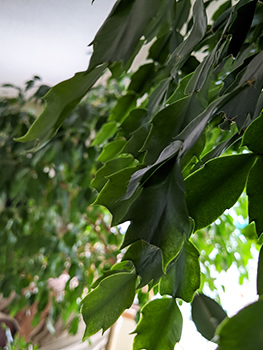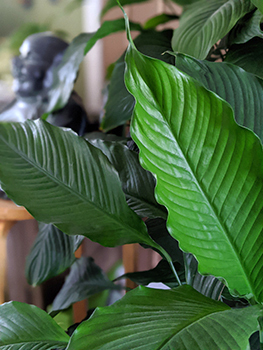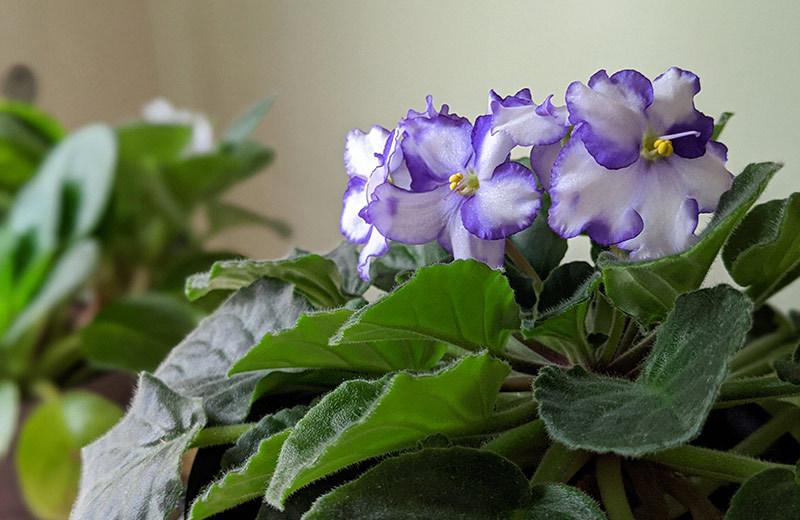Parks Canada suggests that spending time in nature, surrounded by greenery and fresh air, is beneficial to our mental well-being. Nature Canada also touts the benefits of the outdoors and references forest bathing: “the act of being among nature and taking in the sights and sounds of your surroundings.” We certainly live in a great place to follow that advice, as Canada has “more than 17 times the world average” in natural forest space per person in which we can immerse ourselves. This need for a connection to nature, known as biophilia, is a year-round desire, but what do we do when winter hits? Where can you find that greenery and smell of damp earth to help you feel grounded, calm, and refreshed? The answer may be houseplants!

Here in Northern BC we struggle with the reduced amount of daylight available in our indoor spaces and must therefore choose plants that can thrive on less light or grow under artificial lights. As an owner of over 35 houseplants, down from a record 65 at one time, I can certainly provide advice on some of my favourites to add to (or start) your houseplant collection.
- African violet (Saintpaulia) – This small, simple plant will reward you for years with regular blooms of flowers, if you do not overwater them. I water mine from the bottom and never from the top to avoid damaging the leaves. Be sure to sit the plant in a decorative bowl or plant tray for easy watering.
- Christmas cactus (Schlumbergera bridgesii) – If you want low maintenance and amazing bright flowers in the middle of winter, get a Christmas cactus! After flowering, I twist off the front one or two leaves to help keep the plant compact. It has heavy branches that can break off when they get too large for the pot, or the pot can fall over (or off a shelf!).
- Fig tree (Ficus benjamina) – If you have the space, this plant will grow into a great indoor tree – just plan for it to take up an entire corner or window in 15 years. I have two of these in my home that are both 20 years old – one over five feet tall, the other only one foot tall as it has been grown as a bonsai. Trim fig trees at least twice a year to keep them bushy and shapely. I also shower my trees twice a year to remove dust and provide a deep watering. Do not be alarmed if your mature fig trees lose leaves in the fall or winter months. This is a natural cycle and in a few weeks, new leaves will grow.
- Peace Lily (Spathiphyllum) – I have had peace lilies live for decades and endure lightless corners and neglect! The bright white flowers last for weeks and really pop and draw attention to the plant. If I have neglected mine for too long, I just pop them in the shower for a good dust-off and thorough watering.

Peace lily leaf freshly unfurled. - Ponytail palm (Beaucarnea recurvate) – This stunning plant is so easy to care for because it’s actually a succulent and not a palm. Visitors to your home will be asking what it is! Be careful of the leaves though as they are sharp along the edges and can cause injuries similar to a paper cut. This plant can live for decades and can be grown as large as a tree or kept tidy and small if grown as a bonsai.
You may have noticed a theme with all the plants on the list? That’s right, they all require less light, less attention, and less water. I have found the biggest mistake made with houseplants is overwatering.
I will leave you with a few quick tips for your houseplant success:
- Ensure your pot has excellent drainage out of the bottom into a plant tray.
- Fertilize sparingly with liquid fertilizer you can add to the water.
- Invest in the different types of fertilizers for green plants, African violets, and succulents.
- Larger plants are easier to take care of, so be sure to buy the largest plant in the largest pot that you can afford and have room for.
- Repot your plants every few years in new soil and increase the pot size if needed.
- Shower your green plants (but not violets or succulents) a few times a year to remove dust, purge excess salts built up from the fertilizers, and to get oxygen to the roots.
- Use a dry and very soft paintbrush to dust off violets and succulents a few times a year.
Good luck with your houseplant adventures and please share in the comments how you got green to ward off the winter blues!
Read the second article in this series "Getting green to ward off the winter blues: Part two".














Comments